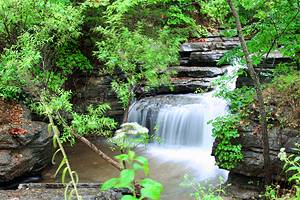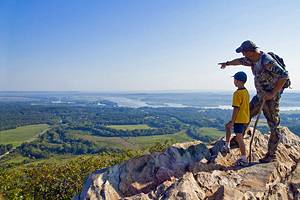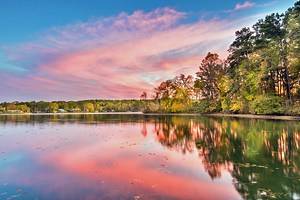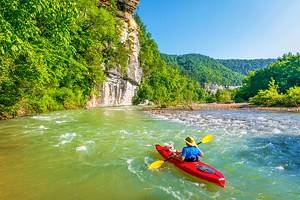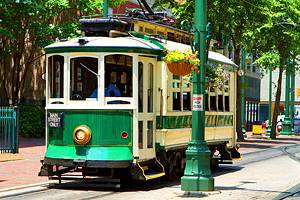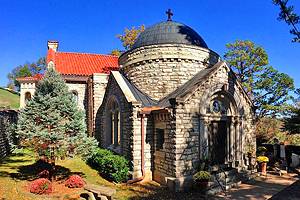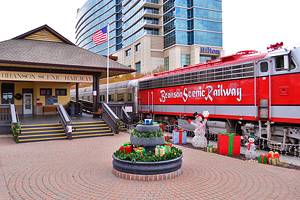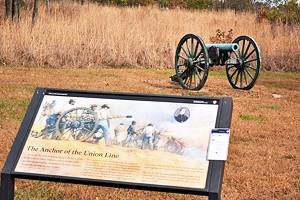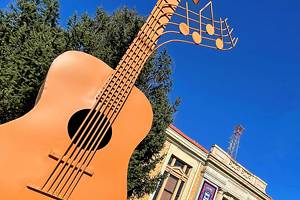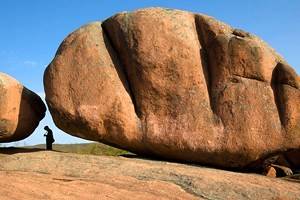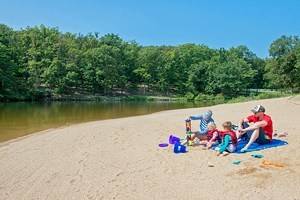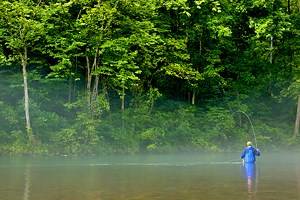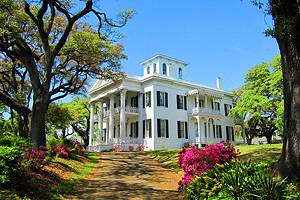Tourist Attractions in Little Rock, AR
Author Anietra Hamper has spent time traveling throughout Arkansas exploring outdoor recreation and the state's top experiences.
Little Rock has hospitable Southern warmth ready for your arrival from the minute you step into town, whether you are planning a full vacation or just a weekend getaway. History and arts are immediately noticeable, from the sculptures that fill the Little Rock landscape, culminating with the Vogel Schwartz Sculpture Garden stretching along the riverfront.
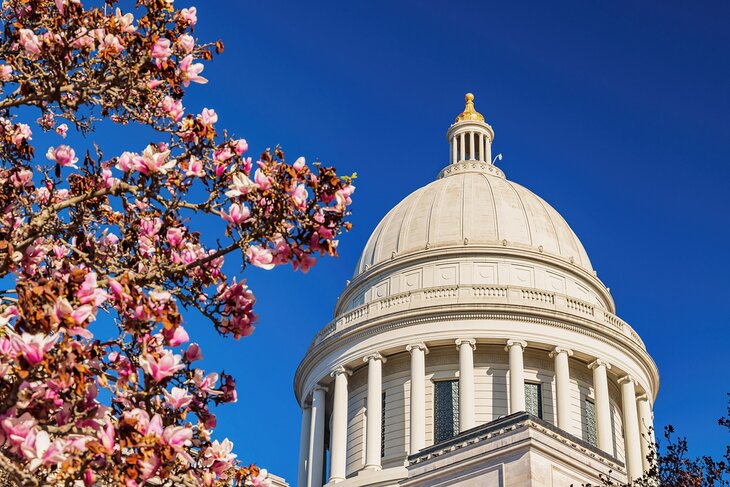
You can meander on foot, by car, or by scooter and see a wide range of significant American history in town. The Governor's Mansion Historic District covers a large portion of the downtown area, preserving some of the unique designed and historic homes and buildings. Many of Little Rock's main tourist attractions are just a few blocks from each other and there is a great walkable downtown.
Just across the river in North Little Rock, fans of Gone with the Wind will want to visit the Old Mill, where early scenes of the film were shot. Small, intimate eateries that range from casual to fine dining will make you feel like a local.
For more ideas on places to visit and how to spend your time here, see our list of attractions and things to do in Little Rock, Arkansas.
- William J. Clinton Presidential Center & Park
- Little Rock Central High School National Historic Site
- Arkansas River Trail & Big Dam Bridge
- River Market District
- State Capitol
- Go for a Hike at Pinnacle Mountain State Park
- ESSE Purse Museum
- Old State House Museum
- Vogel Schwartz Sculpture Garden
- Museum of Discovery
- Mosaic Templars Cultural Centre
- MacArthur Museum of Arkansas Military History
- See the Animals at the Little Rock Zoo
- Arkansas Museum of Fine Arts
- Historic Arkansas Museum
- Historic Homes Driving Tour
- Wildwood Park for the Arts
- Arkansas Inland Maritime Museum
- Step Back in Time at The Old Mill
- Map of Attractions & Things to Do in Little Rock, AR
- Little Rock, AR - Climate Chart
William J. Clinton Presidential Center & Park
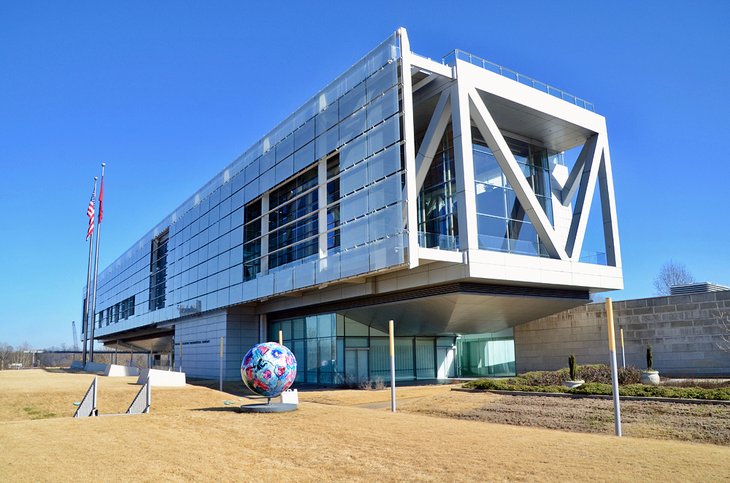
One of the attractions that forever changed the landscape of Little Rock is the Clinton Presidential Center & Park, home to the William J. Clinton Presidential Library and Museum. The modern and rectangular building on the Arkansas River is designed to echo the former President's "Bridge to the 21st Century" mantra that he focused on during his presidency.
The multi-building facility has an archival research facility and a museum. There are interactive exhibits and more than one million photos, artifacts, presidential itineraries, and gifts that Clinton received as president on display throughout the three floors of the complex.
You should plan to spend two to three hours in the center with a must-see list that includes the Great Hall, which is the best place to see the architectural details of the building, and the full-scale replica White House rooms of the Cabinet Room and Oval office. Each features the exact details of those rooms in the White House during Bill Clinton's presidency down to the Resolute Desk in the Oval office.
The grounds outside the Clinton Presidential Center are worth walking to see the sculptures, fountains, and restored wetlands to support local wildlife.
Address: 1200 President Clinton Avenue, Little Rock, Arkansas
Little Rock Central High School National Historic Site
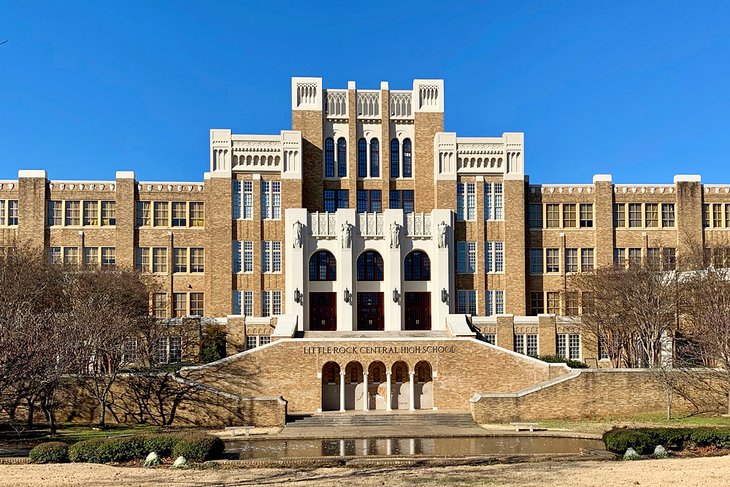
Highlight: The grounds around the school have symbolic significance, including the Elizabeth Eckford Bus Bench and the commemorative garden.
Little Rock Central High School National Historic Site was the center of school desegregation in 1957 after the landmark case of Brown v. Board of Education. Nine African-American teenagers, historically referred to as the Little Rock Nine, became the focal point of the desegregation debate when they tried to enter Little Rock Central High School as it was legalized.
The nine students walking into school, escorted by the U.S. Army, became a pivotal moment in Civil Rights history. Little Rock Central High is still an active school, and the only way to tour this historic site is by reserving a ranger-led tour ahead of time. The importance of this site to American history makes it one of the best tourist attractions in Arkansas.
You can walk around the outside on your own to admire the towering architecture and appreciate the significant events that happened on the steps of the school that made an impact on every public school in the United States.
Address: 2120 W. Daisy L Gatson Bates Drive and Park Street, Little Rock, Arkansas
Arkansas River Trail & Big Dam Bridge
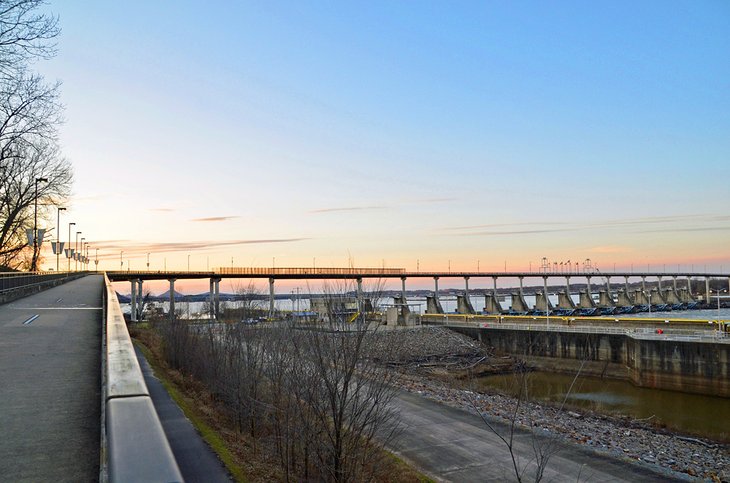
Highlight: The Big Dam Bridge, the longest pedestrian bridge in the world accessed by foot or bike.
A run, walk, or bike ride along the Arkansas River Trail, which runs through Little Rock, is a great thing to do to experience some of the best sites and attractions in the city and soak in some of the scenic outdoors that surround it. The Arkansas River Trail is a 15.6-mile loop that is popular with runners and bicyclists, and connects multiple pedestrian bridges and more than 23 attractions and parks. It also connects to more than 70 miles of additional trails.
When the weather is nice, you can use the trail as your map to visit Riverfront Park, the Clinton Presidential Center, Vogel Schwartz Sculpture Garden, and the Arkansas Inland Maritime Museum, as well as other tourist attractions.
There are multiple pedestrian bridges along the Arkansas River Trail that cross the Arkansas River, and you should try to experience them while in Little Rock. The Big Dam Bridge is the longest pedestrian and bicycle bridge in the world and connects Little Rock to North Little Rock on the opposite banks of the River. One of the best times to visit is at sunset, when a rainbow of colors reflects off the river 90 feet below the bridge.
Another must-experience is the Clinton Presidential Park Bridge, the Rock Island Railroad Bridge that was built in 1899 and repurposed into a pedestrian walkway. It provides a great view of downtown, the Arkansas River, and the Clinton Presidential Center. It is especially pretty at night when it is illuminated in color.
River Market District
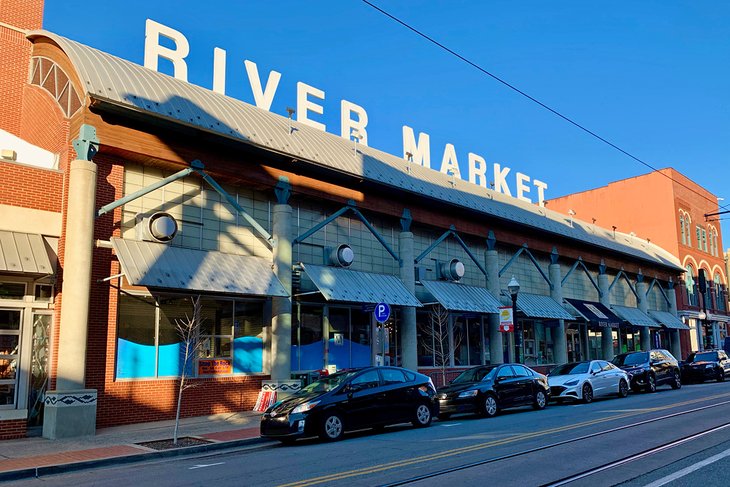
Highlight: Local vendors selling unique products like regional food and art all in one space.
The heart of the River Market District is the year-round market space offering 10,000 square feet of shops, stalls, and tables that sell food and unique products. The market hall is an open-concept building with food stalls, coffee vendors, groceries, and take-out options.
The River Market District offers more than just shopping. There are art galleries nearby with changing exhibits; the River Market Entertainment District; and Riverfront Park, which has more than 30 acres of green space and art.
While you are in the walkable district, plan a ride on the Rock Region METRO Streetcar, a vintage electric streetcar that offers free rides downtown.
The River Market has easy access to the scenic Arkansas River Trail for walking or biking. Special events occur at the River Market District throughout the year, ranging from big-name concerts to Fourth of July fireworks over the river.
Address: 400 President Clinton Avenue, Little Rock, Arkansas
State Capitol

Highlight: Several bronze statues around the capital including one honoring the Little Rock Nine
Based on the design of the U.S. Capitol in Washington, the Arkansas State Capitol is made of white marble and granite. The front entrance doors for the State Capitol are made of bronze, and the cupola is covered in 24-karat gold leaf. Visitors can explore the building on a scheduled tour.
Popular public areas of the capitol include the Governor's Reception Room, the Old Supreme Court Chamber, and a glistening rotunda. Permanent and rotating exhibits can be found throughout the building, and the landscaped grounds outside feature walking paths and commemorative statues.
One of the most powerful bronze sculptures to look for is one commemorating the Little Rock Nine, the brave students who played a significant role in the desegregation of city schools in 1857. The sculptures feature plaques with quotes from each of the nine.
Address: 500 Woodlane Street, Little Rock, Arkansas
Go for a Hike at Pinnacle Mountain State Park

Highlight: Hiking trails lead to the summit with some of the best panoramic views in the region.
Just over 15 miles northwest of downtown Little Rock, Pinnacle Mountain State Park is the best place to visit for a little outdoor fun. The mountain stands well over a thousand feet above the surrounding river valley.
Two hiking trails that lead to the summit provide unbeatable views, and miles of other multi-use trails wind through the nearly 2,500 acres of state park property.
Other popular activities and amenities at this day-use state park include interpretive programs, boat launches, and picnic sites. Camping is not available at Pinnacle Mountain, but more than 100 campsites can be found at Maumelle Park, less than five miles away, and it has one of the best lakes in Arkansas for water recreation.
Address: 11901 Pinnacle Valley Road, Little Rock, Arkansas
ESSE Purse Museum
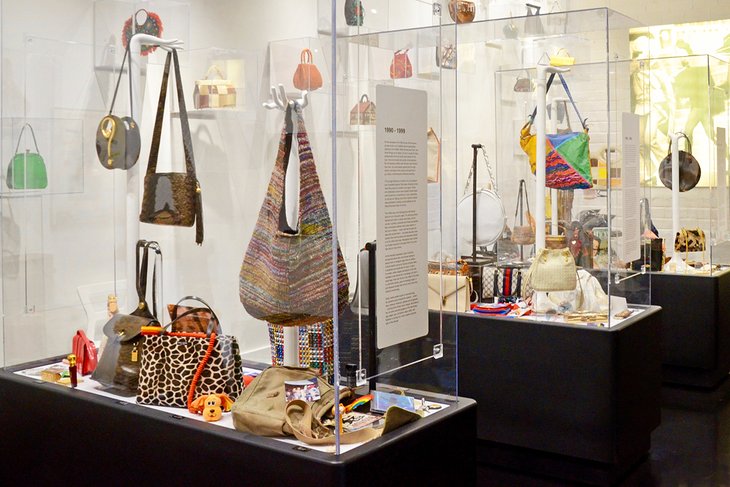
Highlight: Pop culture purses with inspired designs from some of the most iconic brands throughout the decades
The ESSE Purse Museum in Little Rock is a unique and engaging museum that features women's history through handbags. The exhibits are categorized by decade and highlight the social and pop culture scene of each era, along with how women's handbags evolved to reflect the culture and needs of that time.
The collection belongs to owner Anita Davis, who honors women of all backgrounds and her love of art, history, and of course, handbags. There are no two alike, and each reflects a unique moment in time. From dainty designer beaded handbags to novelty bags of pop culture brands, each has a place in women's history.
The museum's name, "ESSE," means essence and conveys the importance of women's handbags as not just totes for personal items, but as a personal extension of themselves. You cannot leave the museum without spending time in the ESSE store, where you might just head home with a conversational piece on your arm.
Address: 1510 Main Street, Little Rock, Arkansas
Old State House Museum

Highlight: A collection of inaugural gowns from some of Little Rock's First Ladies
As the original state capitol of Arkansas, the Old State House was designed by Gideon Shryock and is one of the best examples of Doric architecture in the southern states. The building commenced in 1833 and was completed in 1842 with some alterations done in 1885.
The Old State House Museum sits in the center of Little Rock and is an easy stop on your way through the River Market District. It is free to visit and is one way to learn about important historical events, like a fatal duel between legislators and the Arkansas vote to secede from the United States.
The museum exhibits include artifacts related to decorative arts, inaugural gowns of governors' wives, and historical displays relating to the politics of the state.
Address: 300 West Markham Street, Little Rock, Arkansas
Vogel Schwartz Sculpture Garden
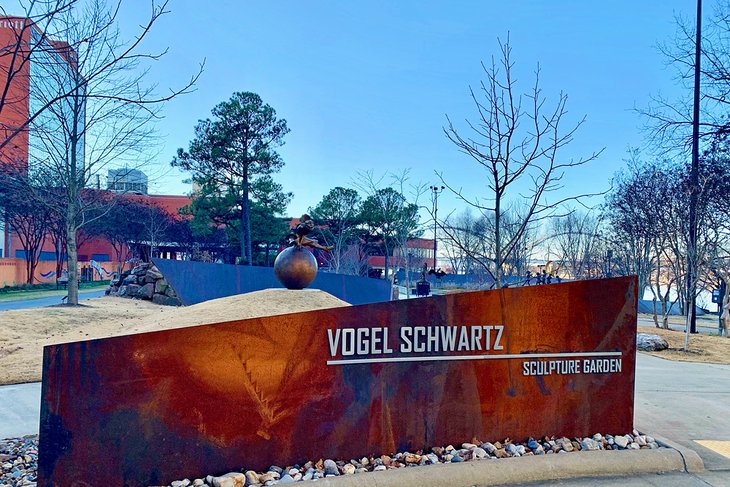
Highlights: Walking path throughout the public sculpture garden along the riverfront
The Vogel Schwartz Sculpture Garden is one of the most inspiring art displays that you can find in any city. Around 90 pieces of public art are throughout the downtown riverfront, and a majority of them are in the Vogel Schwartz Sculpture Garden. Look closely along the walkways and in the greenery as each sculpture elegantly accents the gardens and pathways along the river.
The public space is inviting and allows you to enjoy the art at your own pace. The large sculptures by the river that seem to accent the bridges behind them are easy to find, but there are smaller, more delicate statues, too, that require a keen eye. From eclectically modern to elegantly inspiring and reflective, this collection of public art is a nice way to wrap up a day of sightseeing in the city.
Address: Riverfront Park, Little Rock, Arkansas
Museum of Discovery
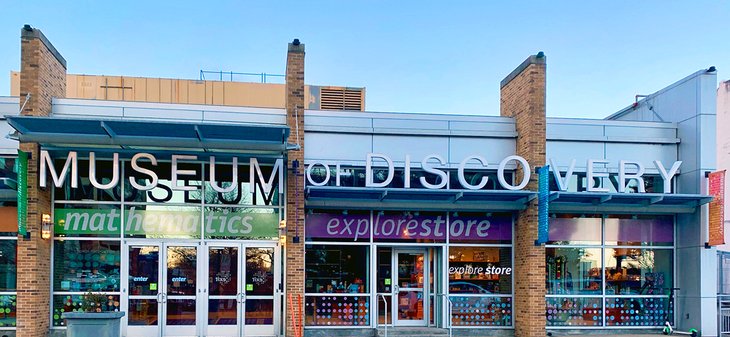
Highlights: Rotating seasonal events and interactive exhibits for kids, including a Tornado Alley Theater
The Museum of Discovery is an ideal family destination in Little Rock. Once you step inside, you'll be hard-pressed to hold back your kids as they rush from one interactive display to another. In addition to the displays, children and adults alike are encouraged to participate in experiments.
A couple of highlights are the Bed of Nails, Pet Clinic, Tesla Coil, Tinkering Studio, Amazing You, and Earth Journeys. One of the most interesting exhibits and important educational experiences that should not be missed is the Tornado Alley Theater. Step inside and experience the tornado that ripped through town back in January 1999.
Address: 500 President Clinton Ave., Suite 150, Little Rock, Arkansas
Mosaic Templars Cultural Centre
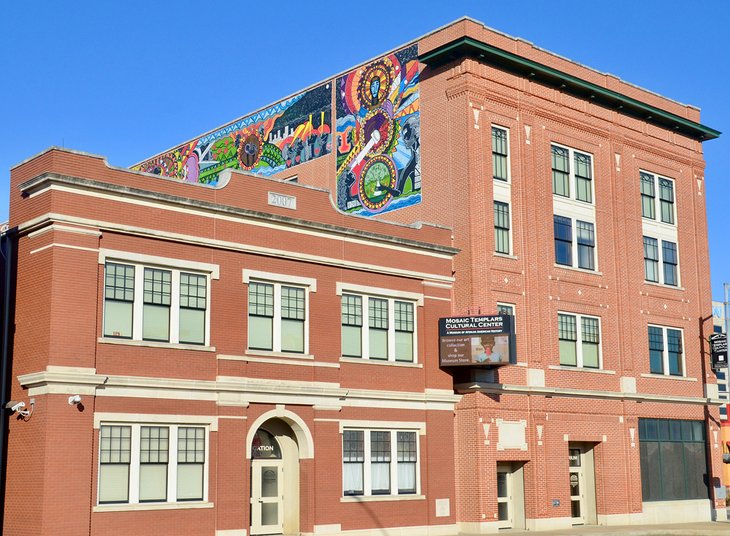
Highlights: Intricate mosaics decorate the outside of the building
Just looking at the exterior of the Mosaic Templars Cultural Centre is inspiring, with intricate designs that draw your curiosity. The museum's focus is on educating visitors about the African American life experience in Arkansas.
The name originated from a fraternal organization in Little Rock founded in 1883. The building once served a practical use for the organization, but now it is a public museum, with exhibits and information about African American history in the state.
Some of the permanent exhibits include the history of the building, a children's gallery, and a theater. The cultural center also supports collections and research for those looking to find historical information. There are also educational programs offered at the center throughout the year.
Address: 501 W. 9th Street, Little Rock, Arkansas
MacArthur Museum of Arkansas Military History
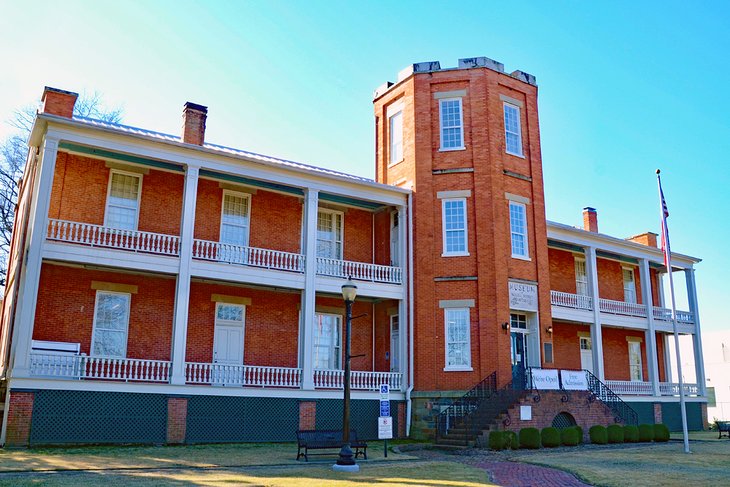
Highlights: Unique overnight accommodations on the grounds of the museum
The MacArthur Museum of Arkansas Military History is housed in the historic Tower Building, part of the Little Rock Arsenal. The museum explores the military history of the state through artifacts, photographs, documents, uniforms, weapons, and other military items.
The building is one of the oldest in the region and was the birthplace of General Douglas MacArthur. Surrounding the museum, MacArthur Park also has many other attractions, including contemplation gardens and veteran memorials. For a unique lodging option, the HI Little Rock Firehouse Hostel & Museum within the park is a fun place to spend the night.
Address: 503 East Ninth Street, Little Rock, Arkansas
See the Animals at the Little Rock Zoo
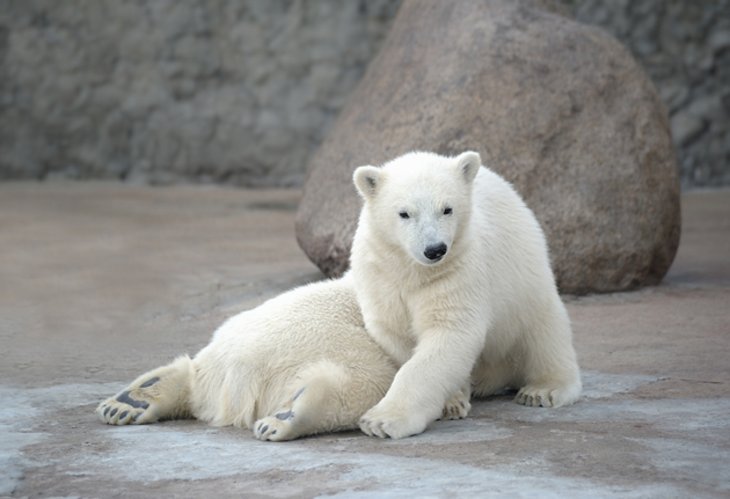
Highlights: A ride on the historic Arkansas Over-the-Jumps Carousel, operating since the 1800s
As an accredited member of the Association of Zoos and Aquariums, the Little Rock Zoo maintains a collection of animals, with approximately 200 different species from around the world. While this is not a huge zoo, it does maintain a good collection of large and exotic animals including, elephants, giraffes, big cats, rhinos, and bears.
Hands-on interactions with animals create lasting memories and make for fun photos and are a popular feature of the Arkansas Heritage Farm pavilion. Other animal interaction opportunities at the zoo include fish feeding and lorikeet landing stations.
Address: 1 Zoo Drive, Little Rock, Arkansas
Arkansas Museum of Fine Arts
Highlight: Outdoor dining at the museum's restaurant overlooking MacArthur Park
The Arkansas Museum of Fine Arts underwent a 150-million-dollar renovation, renewing the city's commitment to visual and performing arts. The institution has been an evolving effort to exemplify arts in the state, with the first center opening in 1937.
Gallery exhibitions feature artwork from private collections, making this an important stop for anyone interested in rare art and art history. Performing arts are a key part of the center with music, dance, and theater performances.
Address: 2510 Cantrell Road, Little Rock, Arkansas
Historic Arkansas Museum
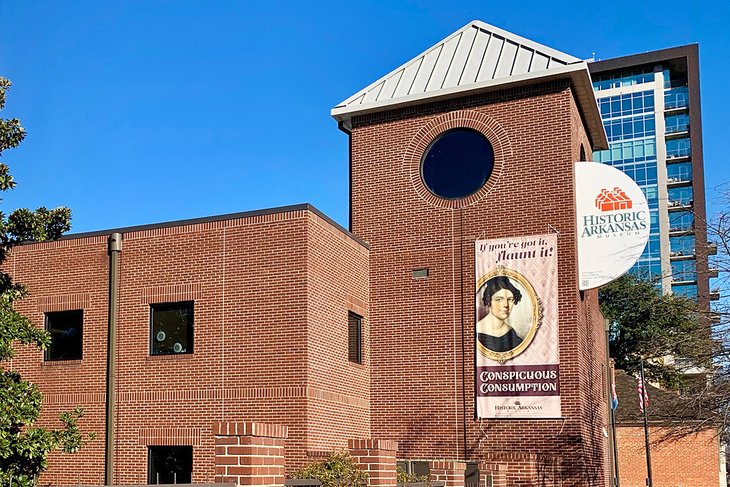
Highlights: Living history programs with performers that bring some of Little Rock's oldest buildings to life
The Historic Arkansas Museum is an 1850 farmstead, and houses some of the oldest buildings in Little Rock on a single city block in the downtown area. This is a nice place to visit for history buffs who want to experience life in Arkansas in the mid-19th century.
The restored buildings give insight into Little Rock's heritage in the frontier era. It is a living history museum, so you will want to plan your visit when there are performers on-site playing the parts of homeowners and period characters to bring this era to life.
Address: 200 E. Third Street, Little Rock, Arkansas
Historic Homes Driving Tour
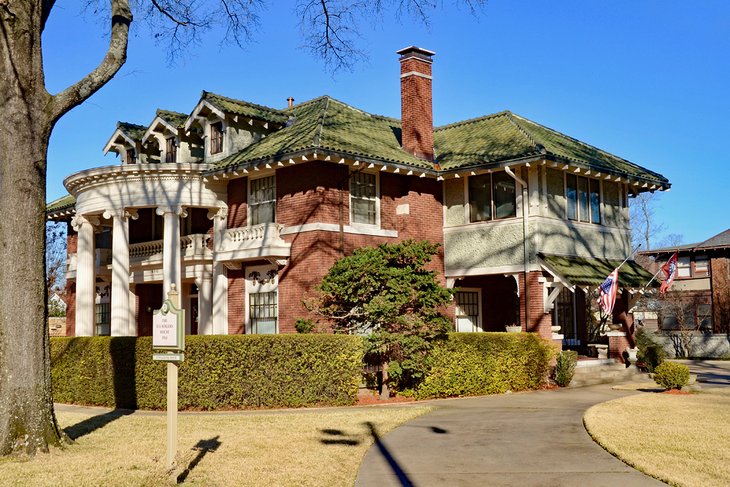
Highlight: Several districts of historic homes are easy to navigate on your own.
Whether you choose to take a self-guided driving or walking tour through the Quapaw Quarter District or just casually cruise through, it is important to the history of Little Rock. See over 100 historic and renovated homes that each have a distinct design and architecture.
There are also several preserved buildings and churches in the district that give insight into how Little Rock bloomed from a small town into a booming city after the Civil War. The Quapaw Quarter is nine square miles and includes 15 historical districts, including the Governor's Mansion Historic District.
Most of the homes have placards in the yards with information about the original owners and the date of construction. The Quapaw Quarter is comprised primarily of residential neighborhoods, so the best way to experience it is to get out and walk the sidewalks.
Wildwood Park for the Arts
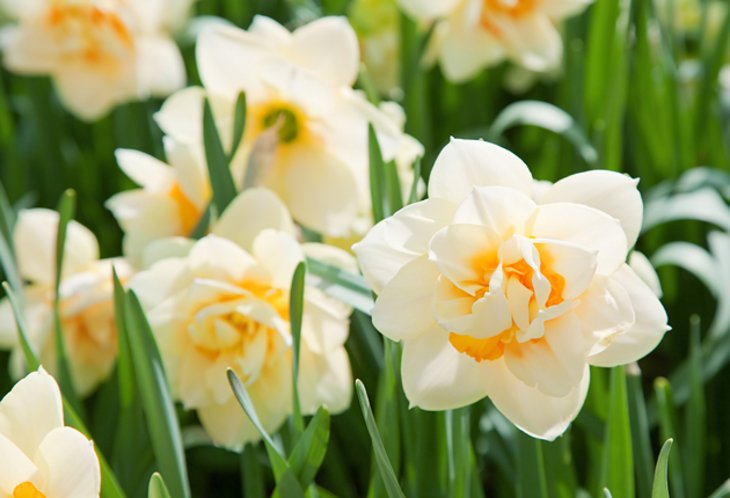
Highlight: Outdoor performances, festivals, and public activities surrounded by gardens, gazebos, and wildlife
Wildwood Park is a park for music and the performing arts, designed for indoor and outdoor performances. With 104 acres, the park also has a number of gardens and smaller facilities. Within Wildwood, the Butler Arboretum contains daffodils and native flowering trees, and the neighboring Gertrude Butler Gazebo features a daylily garden and scenic views of Swan Lake.
Other gardens worth exploring include Bruce Garden, home to native perennials and decorative grasses, and the Asian Woodland Garden with a ceremonial tea house and wide array of Japanese plants.
The park is an ideal place to bring the kids and go for a hike along one of the many trails in the woods. Later on enjoy a picnic lunch under one of the lakeside gazebos; if you are lucky, the resident swans will make an appearance.
Address: 20919 Denny Road, Little Rock, Arkansas
Arkansas Inland Maritime Museum
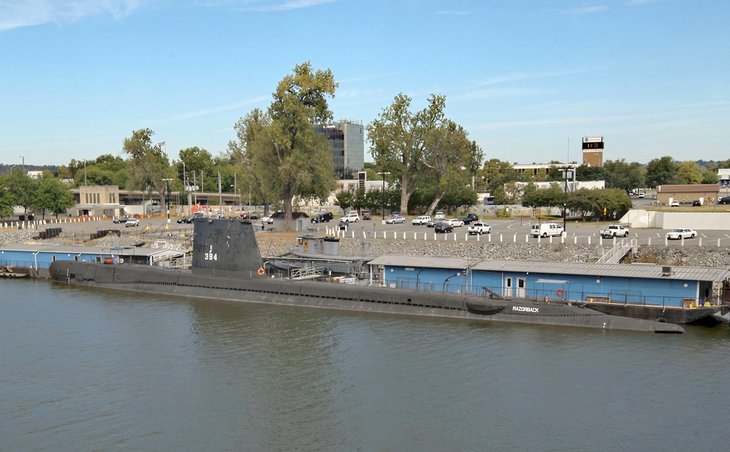
Highlights: Restored WWII tugboat and submarine on display for a close-up view
The Arkansas Inland Maritime Museum can be found alongside the Arkansas River in North Little Rock. The main attractions at this naval museum include two floating vessels involved in World War II — a tugboat recognized as a Historic National Landmark, and a USS Razorback submarine that was present in Tokyo Bay when Japan formally surrendered the war.
Visitors can take a guided tour on and into the operational submarine, getting a good sense of the inner workings of the ship. On dry land, the museum and North Shore Riverwalk also display memorials and a peace garden.
Address: 120 Riverfront Park Drive, North Little Rock, Arkansas
Step Back in Time at The Old Mill
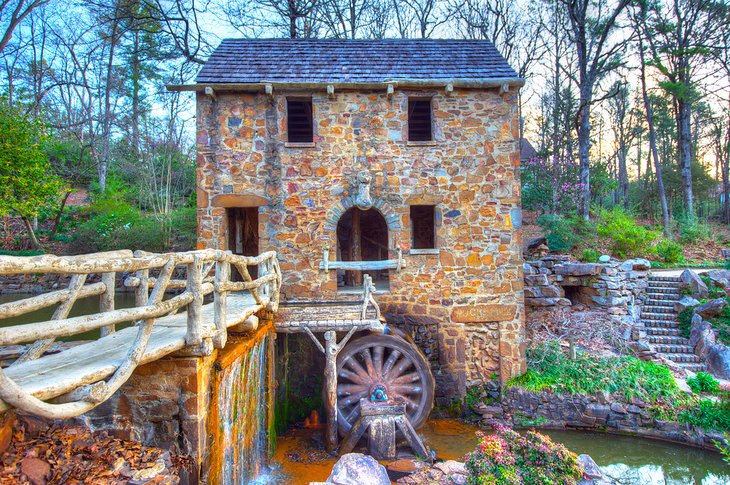
Highlight: The mill's iconic and preserved image, made famous in the movie Gone with the Wind.
Since North Little Rock is just a walk across the river, it is worth visiting The Old Mill, which was made famous from the opening scene of the 1939 classic, Gone with the Wind.
The Old Mill is a scenic recreation of an 1800s grist mill surrounded by three acres of landscaped settings. Admission is free to this North Little Rock city park, and one of the best ways to enjoy it is just by walking the grounds.
Apart from The Old Mill itself, the sculptures, created by renowned artist Senòr Dionicio Rodriguez, that adorn the park have landed this natural space on the National Register of Historic Places.
Address: 3800 Lakeshore Drive, North Little Rock, Arkansas
Map of Attractions & Things to Do in Little Rock, AR
Little Rock, AR - Climate Chart
| Average minimum and maximum temperatures for Little Rock, AR in °C | |||||||||||
| J | F | M | A | M | J | J | A | S | O | N | D |
| 10 -1 | 13 2 | 18 6 | 23 10 | 27 15 | 32 20 | 34 22 | 33 22 | 29 18 | 24 11 | 17 6 | 12 1 |
| PlanetWare.com | |||||||||||
| Average monthly precipitation totals for Little Rock, AR in mm. | |||||||||||
| 92 | 85 | 124 | 139 | 128 | 100 | 84 | 74 | 94 | 108 | 146 | 120 |
| Average monthly snowfall totals for Little Rock, AR in cm. | |||||||||||
| 6 | 4 | 2 | 0 | 0 | 0 | 0 | 0 | 0 | 0 | 1 | 1 |
| Average minimum and maximum temperatures for Little Rock, AR in °F | |||||||||||
| J | F | M | A | M | J | J | A | S | O | N | D |
| 50 31 | 56 35 | 64 43 | 73 50 | 81 59 | 89 68 | 93 72 | 92 71 | 85 64 | 75 51 | 62 42 | 53 34 |
| PlanetWare.com | |||||||||||
| Average monthly precipitation totals for Little Rock, AR in inches. | |||||||||||
| 3.6 | 3.3 | 4.9 | 5.5 | 5.1 | 4.0 | 3.3 | 2.9 | 3.7 | 4.3 | 5.7 | 4.7 |
| Average monthly snowfall totals for Little Rock, AR in inches. | |||||||||||
| 2.5 | 1.7 | 0.7 | 0 | 0 | 0 | 0 | 0 | 0 | 0 | 0.3 | 0.5 |
The best time to visit Little Rock, Arkansas is in the spring and the fall when temperatures are not as intense and there is lower humidity than the summer season. Comfortable temperatures are a must, especially for spending time outside walking to tourist sites. The best months to visit are March, April, May, September, and October. March and April experience daytime high temperatures between the low-60s and low-70s.
While you might experience some rain during the spring months, overall, these are more comfortable weather conditions than the summer months of June, July, and August when daytime temperatures hover in the high-80s and 90s with high humidity. The bonus of the spring months is that you will also find slightly reduced hotel rates from the summer vacation season.
The other best months to go to Arkansas are in September and October when temperatures cool slightly to the low-70s to mid-80s during the daytime. These are great months to visit tourist attractions and comfortably enjoy venues like evening outdoor amphitheater performances. These months also have less rain and can experience the fall colors changing in Arkansas' dense forest regions.


